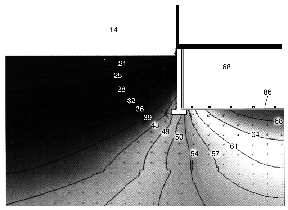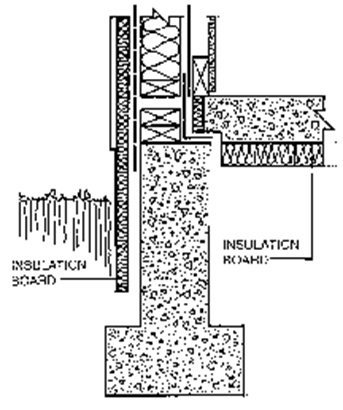When - Where - How
by Lawrence Drake
published the Radiant Panel Report, July 2000
Questions
A common question that occurs during the design stage of a heated slab installation is one of slab insulation. Is it really necessary? If so, where and how much? The rule of thumb seems to be, "the more difficult it is to calculate, the less likely it is to be applied." Calculating heat loss from a heated slab and determining the required insulation is very difficult, so it is often ignored. This doesn't make the heat loss go away, but does reduce construction cost. Too often the building owner pays the price in high utility bills. There are times when there is a valid tradeoff between insulation and slightly higher utility bills. The big question is how to determine where this tradeoff makes sense.
The problem is one of variables. Soil conditions, ground temperatures, groundwater, floor covering and distance from the slab to the surface of the ground, all make heat loss calculations arduous at best. Moist soil is far more conductive than dry soil. Studies show that moist clay soil is more than twice as conductive as dry, sandy loam soil. Wet sand is over three times as conductive as dry, sandy loam soil. Stone is highly conductive. Floor coverings like carpet and pad require much higher slab temperatures than bare concrete or tile floors, driving more heat down into the ground. Placement of the slab in relationship to the ground also affects the slab loss. Heat loss from a slab on grade averages about 15% greater than heat loss through a slab in a full basement.
Slab Heat Loss
There are two areas of heat loss from a heated slab. First, and foremost, is the perimeter loss. This is due to the fact that the shortest distance from the slab to the outside is at the perimeter. The perimeter consists of that band of earth, concrete, block or other construction around the edge of the slab and extending below grade to a stable point in the earth, generally considered to be below the "frost level." In a basement, this is the basement wall and footing.
The second heat loss area is the downward heat flow from the slab. If the ground has no moving water, this heat flow generally moves in a radial pattern down and out to the edges of the slab and then up to the ground surface. All heated slabs and unheated slabs with a conditioned space above, lose heat in this manner.
Slab edge insulation is a given. No one should be installing a radiantly heated slab, basement or on grade, without this important piece of insulation. There are a number of ways to apply slab edge insulation and construction practices often dictate which method to use. The important thing to keep in mind is that there must be a thermal break between the slab and any direct path to the outdoors. A slab may be insulated on the entire bottom side, but if it is poured up against a foundation wall that is not insulated, the heat will travel up the wall and to the outside just like drafting up a chimney. A 4" high, 3/4" EPS insulation between the slab and the wall is money well spent. 1" thick EPS is even better.

This illustration demonstrates the heat loss from a basement slab. Temperatures are in Degrees F.
Where To Insulate
The heat loss from an uninsulated basement wall can be three to four times as much as the heat loss from an unheated, uninsulated basement floor. The basement wall should be insulated without question. Outside or inside the wall is a matter of building design and construction practices. A thermal break around the perimeter of the slab to decouple the slab from the wall is also recommended. These are both items that should be done regardless of whether or not a heated slab is present. Many code bodies require it for energy conservation purposes.
The ASHRAE Fundamentals Handbook shows a range of 0.021 Btu/hr·ft2·°F to .032 Btu/hr·ft2·°F for basement floors 5 to 7 feet below grade. Taking a worst case scenario of .032 Btu/hr·ft2·°F and applying it to a typical house in Minnesota where the design temperature is 20°F below zero, gives a real life example of downward heat loss. More factors have to be entered to get a sample result. If we assume that the basement needs 20 Btu/hr·ft2 to heat the space and it has a typical carpet and pad on the floor (R-2.4), the floor slab will run about 117°F at design temperature. Given the ASHRAE numbers, .032 X (117 (-20)) = 4.38 Btu/hr·ft2 lost through the ground. That is almost a quarter of the heat required to heat the space. Granted, design temperatures only occur for a few hours each year and the ground itself will act as a flywheel through the coldest times. Still, it illustrates that a significant heat loss can occur.
If we apply the same calculation to a milder climate with a design temperature of +20°F, a 15 Btu/hr·ft2 heat load, and a tile floor (75°F slab temperature) [.032 X (75-20) = 1.76 Btu/hr·ft2] the heat loss to the ground will be around 1.76 Btu/hr·ft2. That is still more than 10% of the upward heat load.
Cost Of Heat Loss
So, what does 1 Btu/hr·ft2 cost a building owner in utilities? Obviously the cost of the utility is a factor, but let's just play with some conservative numbers. Say we have a thousand square feet of heated basement floor. Assume that it looses an average of 1 Btu/hr·ft2·hr during a five month heating season. That's 1,000 Btu's per hour for 3,720 hours or 3,720,000 Btus. At Colorado prices of .3825 cents per therm (1,000 Btus), this represents $14.23 per heating season.
A study sponsored by Beaver Plastics, Edmonton, Alberta, Canada suggests that a 1000 square foot basement placed in a climate somewhere between Calgary and Toronto and insulated underneath with 2" of EPS would save about $260 per year (Canadian dollars) at 10 cents per KWH. Converted to Colorado gas prices that is approximately $34.54 (US dollars). Since gas boilers are not 100% efficient, it may be more like $40.00.
Is it worth it to save 5 to 25 cents per square foot per year in utility costs by insulating under the entire slab? That's a call the building owner will have to make. If the building is situated on a high water table or a rock ledge there is only one choice; insulate. Heat loss could be ten times greater where groundwater carries away the floor heat.
Slab Response Time
For those on the fence, there is another good reason for insulating under the entire slab. The slab will respond much faster to control inputs when it is not dragging the ground along as it changes temperature. Insulation under the slab can reduce temperature swings in the heated space and respond quicker to new changes in thermostat settings. This reason by itself can justify the use of under-slab insulation.
Determining How Much Insulation
The RPA Guidelines provide a simple formula for calculating the R-value for heated slab insulation. Subtract the inside design temperature from the outside design temperature and multiply by 0.125. For example a 70° F inside temperature minus a 0° F outside design temperature multiplied by 0.125 equals R-8.75, approximately 2" of polystyrene board insulation. This insulation should at least be installed around the perimeter of the slab to below the frost line. (If this is not possible, it can be installed horizontally four feet under the slab.)
 |
Underslab insulation is typically of the polystyrene board type where R-values greater than R-1.5 are specified. Reflective foil insulation, on the other hand, requires an air space to be effective although some foil products are approved for underslab applications. R-values on these products are generally R-1.5 or less.
For more detailed information on under-slab insulation and calculations, reference the 1997 ASHRAE Fundamentals Handbook, 27.10. |